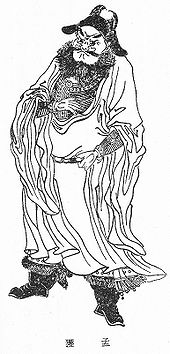Meng Huo
| Meng Huo | |
|---|---|

Qing dynasty illustration of Meng Huo
|
|
| Rebel leader of Nanzhong | |
| Born | (Unknown) |
| Died | (Unknown) |
| Names | |
| Traditional Chinese | 孟獲 |
| Simplified Chinese | 孟获 |
| Pinyin | Mèng Huò |
| Wade–Giles | Meng Huo |
Meng Huo (birth and death dates unknown) was popularly regarded as a local leader representing the gentries of the Nanzhong region during the Three Kingdoms period of Chinese history. The Nanzhong region part of the territories of the state of Shu Han. When the Shu Han emperor Liu Bei died in 223 CE, the local people of Nanzhong rebelled against Shu Han, stating that there were three lords claiming to be the legitimate ruler of China and they no longer knew whom they should pledge allegiance to. In retaliation, the Shu Han chancellor Zhuge Liang launched an invasion on the Nanzhong region and successfully quelled the uprising. The Spring and Autumn Annals of the Han and Jin Dynasties (漢晉春秋) and the Chronicles of Huayang recorded that Zhuge Liang captured and released the local leader seven times until he finally swore allegiance to Shu Han.
Meng Huo's popular image comes from the 14th-century semi-fictional novel Romance of the Three Kingdoms by Luo Guanzhong, who romanticised the events before and during the Three Kingdoms period. The novel portrayed Meng Huo as a southern barbarian tribal leader. He also married the fictional Lady Zhurong, who claimed descent from the fire deity Zhurong.
The Yi consider Meng Huo one of their rulers and call him Mot Hop (Yi language: ꂽꉼ).
The absurdity of Meng Huo being captured and released seven times led many to doubt the story, and even of Meng Huo's existence. The Republican-era historian Zhang Hualan (張華爛) wrote in his article "Discussion on Meng Huo" (孟獲辯) that Meng was a fictional character invented by later historians, noting that the name "Huo" (獲), which means "captured" in Chinese, is too coincidental considering Meng's fate on being captured – a view shared by many academics.
...
Wikipedia
